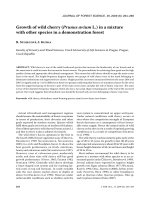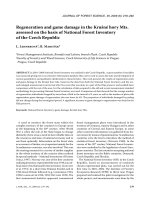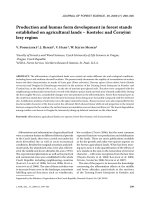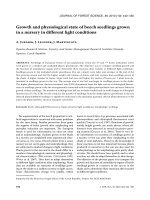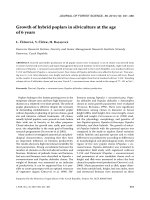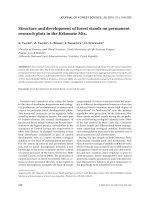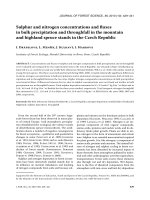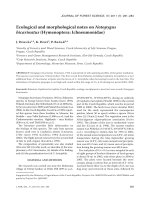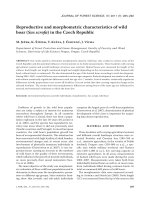Báo cáo lâm nghiệp: "Growth and litter decomposition of woody species inoculated with rhizobia and arbuscular mycorrhizal fungi in Semiarid Brazil" ppsx
Bạn đang xem bản rút gọn của tài liệu. Xem và tải ngay bản đầy đủ của tài liệu tại đây (620.72 KB, 9 trang )
87
Ann. For. Sci. 61 (2004) 87–95
© INRA, EDP Sciences, 2004
DOI: 10.1051/forest:2003088
Original article
Growth and litter decomposition of woody species inoculated
with rhizobia and arbuscular mycorrhizal fungi in Semiarid Brazil
Maria Rita SCOTTI*, Eduardo José A. CORRÊA
Departamento de Botânica, Instituto de Ciências Biológicas, Universidade Federal de Minas Gerais, Avenida Antonio Carlos, 6627, Pampulha,
Cep: 31.270-901 Belo Horizonte Minas Gerais, Brazil
(Received 28 May 2002; accepted 28 April 2003)
Abstract – Jaíba Project is an irrigation enterprise and its forest reserve is one of the largest protected areas of dry deciduous forest of Caatinga.
However, two accidental fires burned about 90% of the area, resulting on the elimination of the trees. This study intended to evaluate the effects
of dual inoculation with Rhizobium and mycorrhizal fungi on growth of Anadenanthera peregrina and its contribution to intercropped native
species (Myracrodruon urundeuva Fr. Allem., Schinopsis brasiliensis Engl. and Acacia sp.) and to increase the soil nutrients through litter
decomposition as a strategy for the restoration of the reserve. The plants of Anadenanthera peregrina which were inoculated with rhizobia strain
BHICB-A10 and associated with AM, showed a significant increase in height and total nitrogen content over that uninoculated plants. In plots
where A. peregrina was inoculated, growth and survival of intercropped plants as Myracrodruon urundeuva, were favoured. This result may
be explained by the faster decomposition rate of M. urundeuva litter and by the increase of soil nutrients which was related with its lowest ligno-
cellulous content. The mixture of A. peregrina with M. urundeuva was the best model for restoration.
bradyrhizobia / mycorrhizal fungi / Anadenanthera peregrina / semiarid / Caatinga
Résumé – Croissance et décomposition de la litière d’espèces ligneuses inoculées avec des rhizobia et des champignons mycorhiziens à
arbuscules dans le Brésil semi-aride. Dans la réserve de forêt sèche de Caatinga, zone d’application du Projet Jaíba pour le développement
socio-économique de cette région semi-aride du Brésil, deux feux accidentels ont brûlé environ 90 % des arbres. La stratégie de restauration de
la réserve réside dans la possibilité d’augmenter l’apport d’éléments minéraux au sol par l’installation de cultures mixtes d’espèces ligneuses
fixatrices et non fixatrices. L’étude a eu pout but d’évaluer les effets de la double inoculation de Anadenanthera peregrina par des souches de
Bradyrhizobium et de champignon mycorhizien à arbuscules sur la croissance de cet arbre et de celle des autres espèces associées natives de
cette région (Myracrodruon urundeuva Fr. Allem., Schinopsis brasiliensis Engl. et l’Acacia sp.). Les effets possibles de cette inoculation sur
la capacité des arbres à augmenter la disponibilité des éléments minéraux du sol provenant de la décomposition des litières de ces arbres
pourraient aider à la restauration de la réserve. La double inoculation entraîne une augmentation significative de la hauteur d’Anadenanthera
peregrina et des autres espèces associées ainsi que leur teneur en azote et leur taux de survie, particulièrement en ce qui concerne M. urundeuva.
Le taux de décomposition plus rapide des feuilles de M. urundeuva pourrait être attribué à un plus faible contenu ligno-cellulosique.
L’association de A. peregrina avec M. urundeuva représente le meilleur modèle à utiliser dans les problèmes de restauration des sols.
bradyrhizobia / champignon mycorhizien à arbuscules / Anadenanthera peregrina / semi-aride / Caatinga
1. INTRODUCTION
Brazil’s semi-arid lands comprise an area of 980 711 sq.
km, distributed throughout 8 states of the Northeast and the
north of Minas Gerais. Inserted in semiarid of Minas Gerais
State, Jaíba Project is an irrigation enterprise, established for
the improvement of agricultural production and for the eco-
nomic and social growth of the region. Climate and vegetation
are between the woody Caatinga or “Dry Deciduous Forest”
and Cerrados (Brazilian edaphic savannas) and such vegetation
is also called “Woody Caatinga” [36] showing as dominant
botanical families: Mimosaceae, Caesalpiniaceae, Fabaceae
and Bignoniaceae [12]. In 1993 two accidental burns reached
about 90% of the ecological reserve, which was seriously
affected with the elimination of trees. Fire may promote soil
degradation depending on the regeneration capacity of the eco-
system. The burned area of forest reserve has been invaded by
species of low load trees and shrub mesh, called “Carrasco veg-
etation” which has restrained the sprouting of woody species.
Thus, a very slow rate of regeneration of valuable tropical spe-
cies of “Woody Caatinga” has been observed [45] such as
Myracrodruon urundeuva Fr. Allem. (Anacardiaceae) that is a
species threatened with extinction [8]. Therefore, the recovery
of the burned Reserve should have priority. A nurse plant phenom-
enon, wherein one plant facilitates establishment of another, has
been described in arid and semiarid regions throughout the
* Corresponding author:
88 M.R. Scotti et al.
world [10]. The most commonly mechanism of facilitation
involves woody plants [16] such as leguminous trees that are
more efficient than non-leguminous in maintaining N and P
availability [30] due to their ability to develop symbiotic asso-
ciations with both rhizobial bacteria and arbuscular mycor-
rhizal fungi (AMF). Bacteria of the genus Rhizobium or
Bradyrhizobium, capable of fixing the atmospheric nitrogen in
root nodules, can guarantee nitrogen supply to the leguminous
tree, making it independent of the nitrogen in the soil. The
access of the roots to the nutrients, especially phosphate, can
be enhanced by the association with mycorrhizal fungi (AMF).
Literature has been confirming that dual inoculation signifi-
cantly increases not only dry weight, nitrogen and phosphorus
content of the shoot, but also the height and diameter of trunk
and reduces plant mortality index [4, 15, 20, 26–28, 38]. This
way such increase of the N and P concentration in the leaves
increases the litter quality and improves the turnover and
decomposition of the biomass which adds nutrients to soil and
produces the soil organic matter (SOM). One of the most sig-
nificant impacts after burning is the loss of soil structure as evi-
denced by a unbalance in soil porosity due the loss of organic
matter (SOM). SOM stabilizes soil aggregates and the porosity,
increases the water holding capacity of soils, influences the soil
fertility and serves as a nutrient sources for soil decomposers
[42]. The rate of plant decomposition depends on the soil chem-
ical composition and many studies have demonstrated the
importance of carbon:nitrogen ratios in determining decompo-
sition rates [9], as well as the importance of ligno-cellulose
index [6], polyphenols [31, 46] and tannin [32] contents in
retarding decomposition. In view of these observations we have
proposed the revegetation of an experimental burned area of
forest reserve with Anadenanthera peregrina (L.) Spegazzini,
a native leguminous tree belonging to Mimosoideae, so called
“angico”, inoculated with Bradyrhizobium sp. and arbuscular
mycorrhizal fungi (AMF). The experimental area was culti-
vated with A. peregrina intercropped with Anacardiaceae spe-
cies: Schinopsis brasiliensis Engl. (aroeira) and Myracrodruon
urundeuva Fr. Allem. (brauna) in blocks 1 and 2 respectively,
and with a leguminous species Acacia sp. (acacia) in block 3
that are also native species of Caatinga. The purpose of the
present study was to determine: (i) the effects of dual inocula-
tion with Rhizobium and mycorrhizal fungi on growth and
nitrogen content of A. peregrina, (ii) the growth of the other
native species in mixed plantation with A. peregrina, and
(iii) the dynamic of litter decomposition, nutrient release and
change of soil nutrient, as a strategy for the reestablishment of
plant species and restoration of semi-arid ecosystems.
2. MATERIALS AND METHODS
2.1. Study site
The study area is located in the Forest Reserve (Woody Caatinga),
in the north of Minas Gerais State in Brazil. It is an area included in
semiarid (15
o
09’ 03” S 43
o
49’ 26” W) characterized by annual plu-
viometric rates of 800mm concentrated in the spring-summer months
from November to January and about 10 dry months. Mean annual
rainfall in 1997/1999 was 238.9 mm in the summer (December to
February) and in dry season (July to October) a water deficit of 35 mm
occurred. The evapo-transpiration potential (EP) is very high with a
relatively low humidity of 12%, according to a report by consultants
[12]. The Forest Reserve has 7 500 hectares and it is one of the largest
protected areas of “woody Caatinga”, the proeminent vegetation
composed by xerophytic trees and shrubs with a total density of
1029.28 trees per hectare. The arboreal stratum showed height of 10
to 25 m [36]. In 1993 two spots of fire reached about 90% of the area,
of which 66.6% was seriously affected with the elimination of trees,
and the area was invaded by a dense community of interlaced shrubs,
coriaceous leaves and never larger than 2 to 5 m [36] characteristics
of Carrasco. Predominant soil types are alic yellow podsols with high
infiltration rate and low levels of organic matter [12]. The mean tem-
perature in a year is 26–29 °C. An area of 1.08 hectare was cleared of
Carrasco plants and prepared for Anadenanthera peregrina cultiva-
tion intercropped with Myracrodruon urundeuva Fr. Allem., Schi-
nopsis brasiliensis Engl. and Acacia sp.
2.2. Soil samples
The samples were collected from the top 20 cm of 10 spots/ block
in a transect of 100 m across each of 3 blocks and mixed for each
block, 4 and 24 months after transplanting. Similar transect was made
in 3 adjacent fields with “Carrasco vegetation”, Caatinga reserve and
in a burned area without woody vegetation (disturbed site) where soil
samples were collected. The samples were analyzed for chemical and
physical properties. The soil analysis was made by Brazilian com-
pany of agricultural research [14]. The texture of the soil was identi-
fied as sandy loam with the textural composition as follows: block 1-
coarse sand = 55%, fine sand = 30%, silt: 4.0%, clay = 11%; block 2-
coarse sand = 57.0%, fine sand = 27.0%, silt = 3%, clay = 13%; and
block 3- coarse sand = 56.0%, fine sand = 28%, silt = 4%, clay = 12%
and chemical analysis is showed in Table III.
2.3. Selection of inoculum and culture conditions
Rhizobial strains (BHICB) used belonging to the collection of the
Federal University of Minas Gerais (UFMG) and were isolated from
Anadenanthera peregrina (L.) nodules collected from other parts of
the country. These strains were previously screened to the appropriate
rhizobia interactions with A. peregrina under greenhouse conditions.
Three rhizobia strains (BHICB-A 10, BHICB-A 41, and BHICB-A 90)
were selected basing in the high growth promoting effect (data not
shown). The bacterial inocula were provided at 1mL per pot (10
8
cfu/mL),
according to Somasegaran and Hoben [43]. Mycorrhizal fungi used
were Gigaspora margarita, Scutellospora heterogama and Glomus
etunicatum, from our laboratory collection of Federal University of
Minas Gerais. Endomycorrhizal inoculation was accomplished by
placing into each pot, 1 mL of suspension composed by 50 spores per
species and 150 spores/mL in total of 3 species (Gigaspora margarita,
Scutellospora heterogama and Glomus etunicatum ). Previous data
(data not presented) indicate the presence of a native mycorrhizal pop-
ulation of Glomus sp. which can potentially set a competition with the
inoculant during the root infection and reduce the inoculation effec-
tiveness. Therefore, the use of three selected mycorrhizal species can
assure the success of inoculation.
2.4. Field experiment and treatments
Seeds of Anadenanthera peregrina (“angico”) were briefly dipped
in 95% ethanol, washed six times in sterile water and germinated in
humid chamber at 29 °C. Seedlings about 10 cm high were trans-
planted into plastic pots of 5 kilograms, filled with soil collected from
burned reserve in Jaiba Project. The following treatments were used
for each group of 120 plants of A. peregrina: (I) Control: complete
fertilization; (triple superphosphate: 500 kg ha
–1
; KCl: 382 kg ha
–1
;
MgSO
4
7H
2
O: 50 kg ha
–1
; ZnSO
4
7H
2
O: 46.8 kg ha
–1
; Mo
7
O
24
H
2
O:
1.76 kg ha
–1
; urea: 222 kg ha
–1
) according to Somasegaran and Hoben
Growth and litter decomposition of woody species 89
[42, 47]; (II) Control plus arbuscular mycorrhizal fungi (AMF);
(III) Fertilization without nitrogen plus inoculation with rhizobia
strain BHICB-A10; (IV) Fertilization without nitrogen plus inoculation
with rhizobia strain BHICB-A41 plus arbuscular mycorrhizal (AM)
fungi; (V) Fertilization without nitrogen plus inoculation with rhizobia
strain BHICB-A90 and arbuscular mycorrhizal (AM) fungi. Each
group of 120 plants of Myracrodruon urundeuva, Schinopsis brasil-
iensis and Acacia sp. received complete fertilization. Plants were kept
in nursery conditions during 4 months before field transplantation.
2.5. Experimental design and sampling procedure
The experiment was set up in a burned area of the Reserve. The
field experimental design was a completely randomized blocks with
three blocks (3600 m
2
each) and five treatments. Five plots (24 ×
30 m), corresponding to each treatment, were distributed in an aleatory
way in each block. Each plot received 40 plants of A. peregrina and
40 plants of one of the native species with a spacing of 3 × 3 m. In the
block I A. peregrina plants were cultivated with Myracrodruon urun-
deuva Fr. Allem., in the block II with Schinopsis brasiliensis Engl. and
Acacia sp. was the intercropped plants in the block III. Four month-
old seedlings were transplanted in the field during the rainy season.
To ensure the survival of the seedlings, irrigation with truck were pro-
vide during the dry season of the first year (10 L/plant/week). Six
plants of A. peregrina from each treatment were harvested 4, 8, and
12 months after transplantation and the leaves were dried to constant
weight at 60 °C and digested for the determination of total nitrogen
by Nessler’s Reagent Method [33] and phosphorus analysis was done
using the Vanado-Molybdate Method [40]. The roots of the collected
plants were carefully dug up and the finer ones picked and clarified.
All the infected and uninfected root segments were selected randomly,
and mycorrhizal infection assessed by the gridline intersect method
[18]. Data were subjected to analysis of variance (ANOVA) and means
separated by Tuckey multiple-range test. The height of all A. peregrina
plants were recorded at 2, 8, 12 and 20 months after transplantation
while the height of intercropped plants were analysed only at
20 months.
2.6. Litter sampling
Leaves of adult plants which had recently fallen over the ground
in August/October were collected. Leaf litter was air dried to a constant
weight at room temperature, cut and enclosed (13 g per bag) in 20 cm ×
20 cm nylon bags made with 1 mm mesh net. Five sub-samples of each
litter type were retained for initial moisture and chemical analyses.
2.7. Experimental design
The field experimental design was a completely randomized block
5 × 2 × 3 with 15 replicates. Fifteen bags of each litter type or treatment
(1- A. peregrina, 2- M. urundeuva, 3- S. brasiliensis, 4- A. peregrina
+ M. urundeuva, 5- A. peregrina + S. brasiliensis), of each time of
analysis (4 and 8 months) were laid at the bottom of a hole (5 cm deep)
in each of the 3 blocks (50 m × 50 m), where A. peregrina and inter-
cropped species were cultivated, with a total of 450 bags. In each block
the bags were incubated in plots where A. peregrina plants were inoc-
ulated with the rhizobia strain BHICB-A10 and AMF. In each sam-
pling date fifteen bags of each litter type were retrieved for analyses.
In the laboratory the leaf litter were removed from the bags, cleaned
and weighed before (fresh weight) and after drying at 60 °C and 80 °C
for 48 h. Corrections for inorganic contaminants were made after
determining ash (4 h, 600 °C).
2.8. Decomposition rates and chemical composition
analysis
Weight loss data was estimated [48] using the following equation:
% RM = (W
0
–W
t
/W
0
) × 100, where W
0
is the initial litter dry weight
and W
t
is the dry weight of the remaining mass (RM) litter in the bag
when collected. The decay rate (K year
–1
) which estimates litter dis-
appearence on an yearly basis and that is proportional to actual decom-
position rates, was calculated using the negative exponential decay
function [34]: W
t
= W
0
e
–kt
.
Chemical determination of the residue,
including soluble components, hemicellulose, cellulose and lignin
were made by the acid detergent fiber method [19] and the analysis
of nitrogen by Nessler’s Reagent method [33] and Phosphorus by
vanado-molybdate method as described by Sarruge and Haag [40] .
3. RESULTS AND DISCUSSION
Inoculation with BHICB-A10 plus mycorrhizal fungi pro-
duced significant differences in height growth of A. peregrina
only 20 months after transplanting (Fig. 1, Tab. I). Before that
time the plants did not show difference in height and this cannot
be attributed to the interaction between block and treatment
(Tab. I). The non significant differences of A. peregrina heights
until the twelfth month (Tab. I) appear to be related to the slow
growth rate of native species under dry season (Fig. 1). The
treatment of BHICB-A10 plus mycorrhizal fungi was the best
(Fig. 1), allowing the plants to reach an average height of 1.95 m.
These results are similar to those described for Acacia pennatula
Table I. ANOVA for height of Anadenanthera peregrina plants as affected by treatments and blocks at 4, 8, 12 and 20 months after field
transplanting.
Time (months)
Sources of variation d.f
4 8 12 20
MS F MS F MS F MS F
Treatment 4 132.36 2.16
NS
133.70 3.43
*
221.44 0.47
NS
266.917 3.68
**
Block 2 900.77 14.69
***
1071.58 27.53
***
6357.64 13.45
***
569.407 7.85
***
Treatment × Block 8 82.26 1.34
NS
78.133 2.01
NS
837.943 1.77
NS
429.67 0.59
NS
Error 60 61.3 38.927 472.820 725.22
Total 74
* Significant at 5%, ** significant at 1%, *** significant at 0.1%, NS: not significant difference.
90 M.R. Scotti et al.
which reached 2 m of height in the first year of cultivation at
two sites in Mexico [38]. In the twelfth month of cultivation,
the plants co-inoculated with AMF and BHICB-A10 presented
a higher in the height growth and in content of nitrogen in dry
matter than those inoculated with the other rhizobia strains.
Since nitrogen content of BHICB-A10 plus mycorrhizal fungi
inoculated was higher than fertilized plants, the strain BHICB-
A10 appears to be an efficient nitrogen fixer (Fig. 2). This inoc-
ulation resulted in a significant improvement in nitrogen content
corresponding to 2.8 g N/plant based on the mean of total dry
weight per plant (108.0 g/plant). These data were compatible
with those observed with Acacia nilotica (2.2 g N/plant) during
the first year of planting in semi-arid land [24]. The presence
of mycorrhizal fungi (AMF) in the roots may improve the
access of the roots to the nutrients, especially phosphate [25].
The fungi develop a mycelium on the surface of the roots that
allows plants to increase the absorption of water and nutrients.
As shown in Figure 2, AMF inoculation enhanced phosphorus
content of fertilized plants only in the fourth month of cultiva-
tion.
After that time, neither phosphorus content nor root colo-
nization (Fig. 2) were significantly different among treatments.
This result may be attributed to a greater availability of soil
nutrients promoted by rainy season [28] and consequently the
reduction of AMF root colonization. Despite the low native
AMF population found in previous studies (1.77 spores/g soil)
the roots of uninoculated plants were well colonized suggesting
higher infective ability of native AMF species, in spite of its
Figure 1. Height (A) of Anadenanthera peregrina
(L) plants inoculated with rhizobia strains (BHICB)
and mycorrhizal fungi (AMF). Means with diffe-
rent letters are significantly different as determined
by Tuckey multiple-range test at the 5% confi-
dence level (P ≤ 0.05). NS: not significantly dif-
ferent.
Figure 2. Nitrogen and phosphorus contents of leaves (dry matter) and root colonization of Anadenanthera peregrina plants inoculated with
rhizobia (BHICB) and mycorrhizal fungi (AMF) 4,8 and 12 months after field transplanting. Means with different letters are significantly dif-
ferent as determined by Tuckey multiple-range test at the 5% confidence level (P ≤ 0.05). NS: not significantly different.
Growth and litter decomposition of woody species 91
inability to provide a significant contribution for the plant’s
growth (Fig. 1). Therefore, the infection rate, done by mycor-
rhizal colonization, could not be correlated to its effectiveness
(Fig. 2). As we have observed and according to literature [3,
37] the extent of root colonization is not an indication of AMF’s
ability to enhance plant growth. AM fungi can benefit the plants
in different ways, not only improving phosphorus and mineral
nutrition [26, 41] but also enhancing absorption of the water during
drought conditions [2, 11]. This possibility may be reinforced
by the results shown in Figure 3 which indicate that AMF inoc-
ulation, single or associated to BHICB-A10 favoured the sur-
vival of all the species. The intensive growth in the root zone
of AMF stabilizes the substrate pore volume, which in turn
increases the water-holding capacity of the soil [2, 44] enhanc-
ing drought tolerance and survival of plants and bacteria [1, 28].
On the other hand, the A. peregrina growth was modified by
the block effects (Tabs. I and II). After 4 and 12 months A. per-
egrina plants of block II, where S. brasiliensis was the inter-
cropping species, grew more than the others, while the plants
of block III, mixed with Acacia sp., showed a smaller growth.
At the end of the analysed period (20 months) the plants of
block I, where M. urundeuva was cultivated together with A.
peregrina, presented the greatest growth (Tab. II). The results
of Table III indicate that soil nutrients such as P, Ca, K, Mg and
carbon, were increased 24 months after transplanting, suggest-
ing that nutrients were released from the litter, specially in
block I. When the growth of intercropped plants was analysed
(Fig. 4), it was observed that Acacia sp. (block III) presented
similar growth to A. peregrina. These results suggest that both
A. peregrina and Acacia sp. species can compete equally with
each other. Acacia growth was modified by inoculation treat-
ments of A. peregrina. Schinopsis brasiliensis is a slow growing
species and consequently their plants exhibited the smallest
growth (Fig. 4) which was not modified by the inoculation
treatments applied to A. peregrina in block II. Nevertheless, in
Table II. ANOVA for height of Anadenanthera peregrina as affected
by each block.
Time (months)
481220
Block I 60.04
b
83.2
a
149
a
195
a
Block II 71.2
a
73.4
b
147
a
177
b
Block III 62
b
70.8
b
124
b
166
b
Means with different letters on each column are significantly different as
determined by Tuckey multiple-range test at the 5% confidence level (P ≤
0.05).
Figure 3. Effect of inoculation procedure of
Anadenanthera peregrina (L.) plants, on sur-
vival index of intercropped species Myracro-
druon urundeuva Engler (Block I), Schinop-
sis brasiliensis Engler (Block II) and Acacia
sp. (Block III), 20 months after transplan-
ting. Each bar is standard error of 30 obser-
vations.
Figure 4. Effect of Anadenanthera pere-
grina (L) plants, inoculated with rhizobia
(BHICB) and mycorrhizal fungi (AMF), on
height growth (cm) of intercropped species
Myracrodruon urundeuva Engler (Block I),
Schinopsis brasiliensis Engler (Block II)
and Acacia sp. (Block III), 20 months after
transplanting. Each bar is standard error of
30 observations.
92 M.R. Scotti et al.
block I the growth of M. urundeuva was improved by AMF
inoculation of A. peregrina plants (Fig. 4) that can be attributed
not only to shade tolerance of M. urundeuva, but also to the better
use of the available nutrient supplied by A. peregrina. Literature
showed that soil nutrients such as nitrogen, phosphorus and
potassium were increased under P. glandulosa more than at
adjacent inter-spaces which may be a mechanism to facilitate
the plant establishment [22]. The soil analysis (Tab. III), shows
a low nutrient content not only in the disturbed site, but also in
soils covered with carrasco, contrasting with those observed in
the undisturbed area. However, an increase of soil nutrients
such as Ca, P and C was observed 24 months after transplanting
in the study site, specially in block I. This way, inoculation treat-
ment which was able to increase the N content of A. peregrina
leaves may have increased the litter production and nutrient
input. On the other hand, mycorrhizal hyphae can obtain addi-
tional nutrient from soil organic matter through their decom-
position ability [21]. Arbuscular mycorrhizal fungi can exist
saprotrophically, enhancing decomposition of organic matter
and increasing the phosphorus and nitrogen capture from com-
plex organic material, independently of the host plant and soil
phosphorus levels. After biotrophic root colonization, arbus-
cular mycorrhizae [23, 39] may increases P uptake from soil
organic phosphate. It is known that mycorrhizal extraradical
mycelium is about 10 times higher than intraradical mycelium
[35] which extend not only the ability to link the organic matter
source to plant roots but also to release nutrients. If mycorrhizal
fungi can decompose the organic matter more nutrients may be
available to the intercropped plants. However, we need to
understand the factors responsible for the better growth of
mixed species in block I in comparison to the other mixtures.
When the decomposition dynamics was analysed it was
observed that the amount of mass remaining and the loss of cel-
lulose and lignin was significantly (P < 0.001) affected by the
time and species (Tab. IV). The mass loss was higher with M.
urundeuva litter than with other species (Tab. V). The leaf litter
of M. urundeuva was decomposed faster than S. brasiliensis and
A. peregrina as shown by the decay rate (K) which allowed to
Table III. Chemical properties of soils 4 and 24 months after transplanting.
Months pH (H
2
O)
Al Ca Mg P K C
(cmol/dm
3
)(mg/dm
3
)%
Block I 4 4.7 0.64 0.26 0.08 0.41 22 0.49
24 4.8 0.56 0.6 0.07 1.9 27.7 1.10
Block II 4 4.7 0.64 0.29 0.06 1.31 19 0.57
24 4.8 0.55 0.46 0.06 2.3 24 0.9
Block III 4 4.5 0.64 0.17 0.04 0.79 16 0.57
24 4.7 0.54 0.32 0.04 1.8 20.2 0.90
Undisturbed area of Caatinga 4 6.0 0.0 3.23 0.40 2.0 115 1.69
Soil under Carrasco 4 4.9 0.42 0.37 0.08 0.29 16 0.7
Disturbed area 4 5.3 0.21 0.38 0.05 0.13 16 0.32
Table IV. ANOVA for mass, cellulose and lignin losses of litterbags leaves as affected by species (type of litter) and time (4 and 8 months)
after field incubation.
Sources of variation d.f
Mass remaining Cellulose remaining Lignin remaining
MS F MS F MS F
Litter types 4 22.08 141.34 1.52 268.5 5.65 253.6
Time 2 342.27 2190.4 10.456 1843.0 0.17 7.84
Interaction 8 0.0666 41.14
***
0.26 45.55
***
1.42 63.57
***
*
P <0.05,
**
P < 0.01,
***
P < 0.001.
Table V. Decay rate and nutrients (nitrogen and phosphorus ) release for each litter type after 8 months of incubation.
Treatments
Mass remain (%)
4 months
Mass remain (%)
8 months
K
(year
–1
)
N released
(mg/g litter)
P released
(mg/g litter)
Lignin:N
(initial composition)
A. peregrina 57.24
a
48.78
a
1.38 170 13.6 5.7
M. urundeuva 33.3
c
20.06
b
2.85 160 10.8 6.1
S. brasiliensis 64.7
a
42.13
a
1.16 120 10.6 14.4
A. peregrina + M. urundeuva 39.01
bc
29.6
b
1.91 195 13.9 5.0
A. peregrina + S. brasiliensis 52.18
ab
51.41
a
1.02 90 9.8 8.9
Means with different letters on each column are significantly different as determined by Tuckey multiple-range test at the 5% confidence level (≤ 0.05).
Growth and litter decomposition of woody species 93
order the annual litter disappearance and nutrient release as:
M. urundeuva > A. peregrina + M. urundeuva > A. peregrina >
S. brasiliensis > S. brasiliensis + A. peregrina (Tab. V). Literature
pointed that decomposition of mixed species can be faster than
single-species [32]. Our results showed that this was true only
for A. peregrina leaves, whose rate of decomposition was
improved when mixed with M. urundeuva, but the highest val-
ues of mass loss were found with M. urundeuva and A. pereg-
rina leaves alone. Literature attributes these differences to the
quality of decomposition material [29, 32]. In the early phase
until the fourth month, concentrations of water soluble sub-
stances decrease quickly (Fig. 5). After 8 months cellulose and
hemicellulose were degraded whereas the recalcitrant lignin did
not decompose. The faster mass loss of M. urundeuva may be
related to the higher initial concentration of water soluble com-
pounds and the lowest cellulose, hemicellulose and lignin content
in leaves (Fig. 5) which may have them become easily decom-
posed by soil microorganisms [5]. In regard to decomposition
rate, an intermediate position was occupied by A. peregrina lit-
ter. While the higher initial water soluble compounds, nitrogen,
phosphorus concentration and lignin/N ratio (Fig. 5 and Tab. V)
improved the decomposition rate, the last one was retarded by
the increase of cellulose and hemicellulose concentration (Fig. 5).
The initial lignin/N ratio has been considered as an important
factor in controlling the earlier phases of decomposition [17].
Based on the lignin/N values of leaf litter in this study (Fig. 5
and Tab. V) we could expect a higher decay index for A. per-
egrina (Tab. V) but it was lower than M. urundeuva which was
Figure 5. Loss of water soluble compounds, cellulose, hemicellulose , lignin and nutrient release of A. peregrina, Myracrodruon urundeuva
and Schinopsis brasiliensis leaves in litterbags, 4 and 8 months after incubation. Means with different letters are significantly different as deter-
mined by Tuckey multiple-range test at the 5% confidence level (P ≤ 0.05). NS: not significantly different.
94 M.R. Scotti et al.
related to lowest cellulose and hemicellulose concentration of
the last one (Fig. 5). The S. brasiliensis litter showed a slow
decomposition rate (Fig. 5) for the opposite reason that is a high
content of cellulose, hemicellulose and lignin. N immobiliza-
tion did not occur in A. peregrina litter (Fig. 5) in agreement
with the results obtained in semiarid-soils of West Africa [13].
The results showed in Table V and Figure 5 suggest that the
mixed litter of A. peregrina + M. urundeuva can favour both
N and P cycling. Studies in African savannas have shown that
N mineralization is high at the beginning of the wet season, but
decrease in dry season [7] and it suggests that the main source
of mineralized N between two wet periods could be dry-season
mortality of microbial biomass. Therefore, A. peregrina + M. urun-
deuva litter may be an additional source of nutrient availability
in dry season considering the decomposition ability of mycor-
rhizal fungi [21]. We can conclude also that biological nitrogen
fixation technology associated with mycorrhizal fungi inocu-
lation plays a role in the growth of inoculated plants of semiarid
lands [1, 16, 20]. Besides, the AMF inoculation of woody leg-
umes appears to facilitate the establishment of both inoculated
legume and uninoculated plants. M. urundeuva was especially
promising for inclusion in mixed plantation with A. peregrina
for restoration programs.
Acknowledgements: This research was supported by Ministry of
Environment (MMA)/ National Found of Environment (FNMA), Bra-
zilian Council for Research Development (CNPq) and (CODEVASF).
Scholarships from CNPq to Maria Rita Scotti and Eduardo Azevedo
are kindly acknowledged.
REFERENCES
[1] Athar M., Johnson D.A., Influence of drought on competition
between selected Rhizobium meliloti strains and naturalized soil
rhizobia in alfafa, Plant Soil 184 (1996) 231–241.
[2] Augé R.M., Schekel K.A., Wample R.L., Leaf water and carbohy-
drate status of VA Mycorrhizal rose exposed to drought stress, Plant
Soil 99 (1987) 291–302.
[3] Bâ A.M., Plenchette C., Danthu P., Dupponnois R., Guissou T.,
Functional compatibility of two arbuscular mycorrhizae with thir-
teen fruit trees in Senegal, Agrofor. Syst. 50 (2000) 95–105.
[4] Beniwal R.S., Toky O.P., Sharma P.K., Effect of V.A. mycorrhizal
fungi and phosphorus on growth and nodulation of Acacia nilotica
(L.) Willd ex Del., Crop Res. 5 (1992) 172–176.
[5] Berg B., Litter decomposition and organic matter turnover in nor-
thern forest soils, For. Ecol. Manage. 133 (2001) 13–22.
[6] Berg B., Ekbohm G., Mcclaugherty C., Lignin and holocellulose
relations during long-term decomposition of some forest litters, Can.
J. Bot. 62 (1984) 2540–2550.
[7] Bernhard-Reversat F., Biochemical cycle of nitrogen in a semiarid
savanne, Oikos 38 (1982) 321–332.
[8] Biodiversitas, Lista de Espécies ameaçadas de Extinção da Flora do
Estado de Minas Gerais, in: Fundação Biodiversitas (Ed.), Belo
Horizonte, 1997, pp. 1–47.
[9] Bossuyt H., Denef K., Six J., Frey S.D., Merckx R., Paustian K.,
Influence of microbial populations and residue quality on aggregate
stability, Appl. Soil Ecol. 16 (2001) 195–208.
[10] Callaway R.M., Nadkarni N.M., Mahall B.E., Facilitation and inter-
ference of Quercus douglasii on understory productivity in Central
California, Ecology 72 (1991) 1484–1499.
[11] Davies F.T., Potter J.R., Linderman R.G., Drought resistance of
mycorrhizal pepper plants independent of leaf P concentration res-
ponse in gas exchange and water –relations, Physiol. Plant. 87 (1993)
45–53.
[12] Del Rey, Distrito de Irrigação do Jaíba- Vegetação e manejo de solos.
Relatório n° 5, Belo Horizonte, 1991, p. 77.
[13] Dommergues Y., Garcia J.L., Ganry F., Microbiological considera-
tions of the N-cycle in West African ecosystems, in: Rosswall T.
(Ed.), Nitrogen cycling in West African Ecosystems, SCOPE/UNEP
Workshop, Idaban, 1980, pp. 55–72.
[14] Embrapa (Empresa Brasilerira de Pesquisa Agropecuária), Manual
de Análises Químicas de solos, plantas, e fertilizantes, Brasília,
1979, pp. 1–369.
[15] Founoune H., Duponnois R., Bâ A.M., Bouami F.E., Influence of
dual arbuscular endomycorrhizal/ectomycorrhizal symbiosis on the
growth of Acacia holosericea (A. Cunn. ex G. Don) in glasshouse
conditions, Ann. For. Sci. 59 (2002) 93–98.
[16] Franco-Pizaña J.G., Fulbright T.E., Gardiner D.T., Tipton A.R.,
Shrub emergence and seedling growth in microenvironments crea-
ted by Prosopis glandulosa, J. Veg. Sci. 7 (1996) 257–264.
[17] Frankenberg W.T., Abdelmagid H.M., Kinetic parameters of nitro-
gen mineralization rates of leguminous crops incorporated into soils,
Plant Soil 87 (1985) 257–271.
[18] Giovanetti M., Mosse B., An evaluation of techniques for measuring
vesicular-arbuscular mycorrhizal infection in roots, New Phytol. 64
(1980) 489–500.
[19] Goering H.K., Van Soest P.J., Forage fiber analysis, in: Agricultural
Handbook No. 379, USDA, Washington D.C., 1970, pp. 1–25.
[20] Herrera M.A, Salamanca C.P., Barea J., Inoculation of woody legu-
mes with selected arbuscular Mycorrhizal fungi and rhizobia to reco-
ver desertified Mediterranean Ecosystems, Appl. Environ. Micro-
biol. 59 (1993) 129–133.
[21] Hodge A., Campbell C.D., Fitter AH., An arbuscular mycorrhizal
fungus accelerates decomposition and acquires nitrogen directly
from organic material, Nature 413 (2001) 297–299.
[22] Johnson H.B., Mayeux H.S., Prosopis glandulosa and the nitrogen
balance of rangelands: extent and occurrence of nodulation, Oeco-
logia 84 (1990) 176–185.
[23] Koide R.T., Kabir Z., Extraradical hyphae of the mycorrhizal fungus
Glomus intraradices can hydrolyse organic phosphate, New Phytol.
148 (2000) 511–517.
[24] Lal B., Khanna S., Renodulation and nitrogen fixing potential of
Acacia nilotica inoculated with Rhizobium isolates, Can. J. Micro-
biol. 39 (1993) 87–91.
[25] Lal B., Khanna S., Long term field study shows increased biomass
production in tree legumes inoculated with Rhizobium, Plant Soil
184 (1997) 111–116.
[26] Manjunath A., Bragyaraj D.J., Gopala Gowada H.S., Dual inocula-
tion with V.A. mycorrhiza and Rhizobium is beneficial to Leucaena,
Plant Soil 78 (1984) 445–448.
[27] Marques M.S., Gonçalves L.M.B., Lemos-Filho J.P., Rocha D.,
Vale M.T.S., Scotti M.R.M., Growth of a leguminous tree (Centro-
lobium tomentosum Guill. ex Benth) inoculated with Rhizobium and
mycorrhizal fungi, Rev. Arg. Microbiol. 29 (1997) 98–102.
[28] Marques M.S., Pagano M., Scotti M.R.M., Dual inoculation of a
woody legume (Centrolobium tomentosum) with rhizobia and
mycorrhizal fungi in south-easthern Brazil, Agrofor. Syst. 52 (2001)
107–117.
[29] Marques M.S., Sá N.M.H., Scotti M.R.M., Decomposition, dynamic
of inorganic elements and microbial colonization of araribá (Cen-
trolobium tomentosum Guill. ex Benth) leaves on latosols of Brazi-
lian Atlantic forest, Agricult. Tec. 1 (2003) 59–68.
[30] Mazzarino M.J., Oliva L., Abril A., Acosta M., Factors affecting
nitrogen dynamics in a semiarid woodland (Dry Chaco, Argentina),
Plant Soil 138 (1991) 85–98.
[31] Meetemeyer V., Macroclimate and lignin control of litter decompo-
sition rates, Ecology 59 (1978) 465–472.
[32] Mesquita R.C.G., Workman S.W., Neely C.L., Slow litter decom-
position in a Cecropia dominated secondary forest of central Ama-
zonia, Soil Biol. Biochem. 30 (1998) 167–175.
[33] Oliveira S.A., Método simplificado para determinação colorimétrica
de nitrogênio em plantas, Ciência e Cultura 38 (1986) 178–180.
Growth and litter decomposition of woody species 95
[34] Olson J.S., Energy storage and the balance of producers and decom-
posers in ecological systems, Ecology 44 (1963) 322–331.
[35] Olsson P.A., Thingstrup I., Jakobsen I., BÅÅth E., Estimation of the
biomass of Arbuscular mycorrhizal fungi on a linseed field, Soil
Biol. Biochem. 31 (1999) 1879–1887.
[36] Rizzini C.T., Tratado de Fitogeografia do Brasil, Editora da Univer-
sidade de São Paulo, São Paulo, 1979, pp. 1–374.
[37] Roldan-Fajardo B.E., Effect of indigenous arbuscular mycorrhizal
endophytes on the development of six wild plants colonizing a semi-
arid area in south-east Spain, New Phytol. 127 (1994) 115–121.
[38] Roskoski I.P., Pepper I., Pardo E., Inoculation of leguminous trees
with rhizobia and V.A. Mycorrhizal fungi, For. Ecol. Manage. 16
(1986) 57–68.
[39] Santiago G.M., Garcia Q.S., Scotti M.R.M., Effect of post-planting
inoculation with Bradyrhizobium sp. and mycorrizal fungi on the
growth of Brazilian rosewood, Dalbergia nigra Allem. ex Benth, in
two tropical soils, New For. 24 (2002) 15–24.
[40] Sarruge J.R., Haag H.P., Análises químicas em plantas. Ed. Escola
Superior de Agricultura “Luiz de Queiroz”, Piracicaba, 1974, pp. 1–56.
[41] Sharma M.P., Gaur A., Bhatia N.P., Adholeya A., Growth responses
and dependence of Acacia nilotica var. cupriciformis on the indige-
nous arbuscular mycorrhizal consortium of a marginal wasteland
soil, Mycorrhiza 6 (1996) 441–446.
[42] Skjemstad J.O., Janik L.J., Taylor J.A., Non-living soil organic matter:
what do we know about it? Aust. J. Exp. Agric. 38 (1998) 667–680.
[43] Somasegaran P., Hoben H.J., Methods in legume-Rhizobium Tech-
nology, Ed. Niftal USAID, Hawaii, 1985, pp. 1–367.
[44] Subramanian K.S., Charest C., Dwyer L.M., Hamilton R.I., Effects
of arbuscular mycorrhizae on leaf water potential, sugar content, and
P content during drought and recovery of maize, Can. J. Bot. 75
(1997) 1582–1591.
[45] Tameirão J.E., Reserva Legal: Avaliação da Cobertura Vegetal,
Relatório No. 1, Belo Horizonte, 1997, pp. 1–16.
[46] Taylor B.R., Parkinson D., Parsons W.F.J., Nitrogen and lignin con-
tent as predictors of litter decay rates: A microcosm test, Ecology
70 (1989) 97–104.
[47] Udaiyan K., Sugavanam V., Manian S., Growth response of wattle
(Acacia mearnsii) seedlings to phosphorus fertilisation and inocu-
lations with Glomus deserticola and Rhizobium sp. in non-sterile
soil, J. Trop. For. Sci. 10 (1997) 212–224.
[48] Wesemael B.V., Litter decomposition and nutrient distribution in
humus profiles in some mediterranean forests in southern Tuscany,
For. Ecol. Manage. 57 (1993) 99–114.
To access this journal online:
www.edpsciences.org
